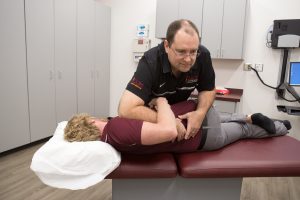When visiting a doctor, you may notice the initials “DO” after their name and wonder how it differs from “MD.” DO stands for Doctor of Osteopathic Medicine — a physician trained in both modern medical practices and a holistic philosophy that treats the body as an integrated, self-healing whole.
In addition to standard medical education, DOs receive specialized training in the musculoskeletal system and use a distinctive technique called Osteopathic Manipulative Therapy (OMT). Dr. Vincent Lobo, DO, DACFP, a seasoned Bayhealth Primary Care Physician with over 40 years of experience performing OMT, shares valuable insights into the uses, benefits, and philosophy of osteopathic medicine.

What Is Osteopathic Medicine?
Osteopathic medicine is a unique branch of the medical profession in the United States. It emphasizes a holistic approach to patient care, focusing on the interrelationship between the body’s nerves, muscles, bones, and organs.
At its core, osteopathic medicine is built on the belief that:
-
The body is a unit where mind, body, and spirit are interconnected.
-
The body possesses an inherent ability to heal itself.
-
Proper structure supports optimal function.
Osteopathic physicians (DOs) practice the full scope of modern medicine, prescribe medications, perform surgeries, and also apply hands-on diagnosis and treatment methods through OMT.
What Is Osteopathic Manipulative Therapy (OMT)?
Osteopathic Manipulative Therapy (OMT) is a set of hands-on techniques used by DOs to diagnose, treat, and prevent illness or injury. Using their hands, DOs apply gentle pressure, stretching, and resistance to:
-
Relieve pain
-
Correct structural imbalances
-
Improve circulation and lymphatic flow
-
Restore natural movement
Dr. Lobo explains that many physical pains and systemic conditions stem from somatic dysfunctions—restrictions or misalignments in the body’s musculoskeletal framework. These dysfunctions may interfere with the normal communication between the brain and various organs, leading to health issues.
For instance, a misalignment in the spine may cause abnormal nerve impulses that negatively affect connected organs. Likewise, a problem with an internal organ, like an inflamed gallbladder, can manifest as back pain.
Conditions Commonly Treated with OMT
OMT can benefit a wide range of conditions by addressing underlying structural problems. Some of the most common issues treated with OMT include:
-
Neck pain
-
Low back pain
-
Tension headaches
-
Chest wall pain
-
Sinus problems
-
Thoracic spine discomfort
-
Temporomandibular joint dysfunction (TMJ)
-
Certain types of abdominal pain
Dr. Lobo emphasizes that treatments are tailored to the patient’s specific condition, age, and needs, making OMT a highly personalized therapy.
Techniques Used in OMT
There are multiple types of OMT techniques, each chosen based on the patient’s diagnosis:
Muscle Energy Techniques
This method involves the patient actively contracting muscles against a physician’s resistance. It’s particularly useful for realigning joints and improving mobility.
Myofascial Release
Similar to a deep tissue massage, this technique targets tightness in the fascia (connective tissues) to relieve tension and restore motion.
Other Common Techniques
-
Soft tissue manipulation
-
Cranial osteopathy
-
Counterstrain therapy
-
High-velocity, low-amplitude (HVLA) thrusts (similar to chiropractic adjustments)
Each approach aims to promote better function, reduce pain, and stimulate the body’s natural healing processes.
The Importance of Preventative Care in Osteopathic Medicine
Preventative medicine is a cornerstone of osteopathic philosophy. DOs like Dr. Lobo not only treat illnesses but also educate patients on maintaining health through:
-
Balanced nutrition
-
Regular physical activity
-
Proper body mechanics (e.g., correct lifting techniques)
-
Use of supportive devices like orthotics
-
Personalized exercise programs
By focusing on prevention, DOs empower patients to take an active role in their health and reduce their risk of future problems.
Do All DOs Perform OMT?
While all DOs are trained in OMT during medical school, not all choose to incorporate it into their practice. Dr. Lobo points out, “It’s another modality of treatment, much like physical therapy or acupuncture. Nothing is 100%, but it’s a valuable option for many patients.”
At institutions like Bayhealth, patients have access to DOs who actively use OMT as part of their comprehensive care offerings.
Why Choose an Osteopathic Physician?
Choosing a DO may offer several unique advantages:
-
A more holistic, whole-body approach to diagnosis and treatment
-
Additional non-invasive treatment options like OMT
-
Emphasis on patient education and lifestyle changes
-
Full-spectrum medical care, from prescription medications to surgeries
Whether you’re seeking help for chronic pain, recovering from injury, or interested in preventative health strategies, osteopathic medicine provides a patient-centered approach that treats more than just symptoms.
FAQs:
What is the difference between a DO and an MD?
Both DOs and MDs are licensed physicians who can prescribe medication and perform surgery. However, DOs receive additional training in osteopathic principles and hands-on musculoskeletal treatment (OMT).
How does OMT help treat health conditions?
OMT focuses on diagnosing and correcting structural issues in the body that may cause or contribute to pain, dysfunction, and even organ problems, promoting the body’s natural ability to heal.
Can OMT replace traditional medical treatments?
OMT is typically used alongside traditional medical treatments, not as a replacement. It complements other therapies to enhance healing and relieve symptoms.
Is OMT safe for everyone?
OMT is generally safe, but treatment techniques are carefully chosen based on individual health conditions, age, and medical history. Always consult with your osteopathic physician to determine the best approach.
What can I expect during an OMT session?
During a session, the doctor will assess your posture, spine, joints, muscles, and other structures. They will then use hands-on techniques such as stretching, pressure, or resistance to address areas of dysfunction.




